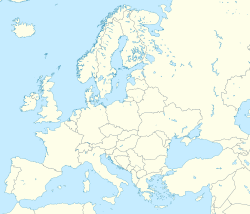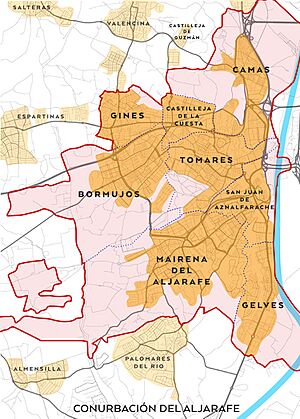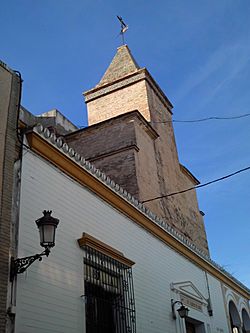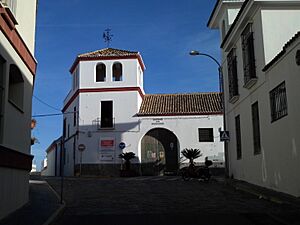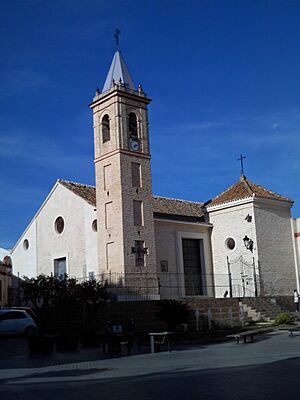Gines facts for kids
Quick facts for kids
Gines
|
|||
|---|---|---|---|
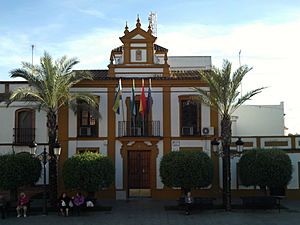
Town hall
|
|||
|
|||
| Sovereign State | Spain | ||
| Autonomous community | |||
| Province | Seville | ||
| Comarca | Comarca Metropolitana de Sevilla | ||
| Government | |||
| • Body | Ayuntamiento de Gines | ||
| Area | |||
| • Total | 2.9 km2 (1.1 sq mi) | ||
| Elevation | 123 m (404 ft) | ||
| Population
(2018)
|
|||
| • Total | 13,471 | ||
| • Density | 4,650/km2 (12,030/sq mi) | ||
| Demonym(s) | Ginense | ||
| Time zone | UTC+1 (CET) | ||
| • Summer (DST) | UTC+2 (CEST) | ||
| Postcode |
41960
|
||
Gines is a small town, also called a municipality, in the southwest of Spain. It's located in the province of Seville, which is part of the Andalusia region. Gines is close to the big city of Seville and is part of its metro area. As of 2021, about 13,529 people live in Gines, and it covers an area of about 2.9 km2 (1.1 sq mi).
This town has a long history, going all the way back to Roman times. People have lived here since prehistoric times! For many centuries, growing olives and making olive oil were very important because the land is so fertile. In the mid-1900s, more and more people started moving to Gines because it's so close to Seville. Now, most of the land is built up, and it connects with nearby towns. Today, Gines mostly has a service-based economy, meaning many jobs are in areas like shops, restaurants, and offices. It's also one of the towns with the highest income in Andalusia.
Contents
Exploring Gines: Location and Nature
Gines sits on a high flat area called the Aljarafe plateau. It's about 123 metres above sea level and only about 6 km from Seville. The towns closest to Gines are Bormujos, Valencina de la Concepción, Espartinas, and Castilleja de la Cuesta. These towns are so close that they form one big connected urban area.
The land in Gines is fertile and drains well, so it's good for farming. However, most of the natural environment has been changed by people building homes and businesses. The traditional way of farming, especially olive groves, has mostly disappeared. This means there aren't many unique natural areas left in the town.
The land in Gines is gently rolling, with some higher areas like the old town and El Majelo neighborhood. The lower parts are near old streams. Geologically, Gines is in the Baetic depression, which means its ground is mostly made of sand, sandstone, and marl from a long time ago.
Two streams flow through Gines: the Meachica stream and the Sequillo stream. Most of these streams are now underground pipes to prevent floods. They carry rainwater away and eventually flow into the Riopudio stream.
Weather in Gines
Gines has a Mediterranean climate, which means it has very hot and dry summers, and mild, somewhat wet winters. Summers are the driest time of year, and winters are the wettest. The average temperature for the whole year is about 18.0 °C (64 °F).
The hottest month is August, with an average temperature of 27.0 °C (81 °F). January is the coldest, averaging 9.7 °C (49 °F). Gines gets about 586 mm (23 in) of rain each year. November is the rainiest month, with about 88 mm (3 in) of rain, while July is the driest, with only about 1 mm (0 in).
It almost never snows in Gines. The last time it snowed a lot was on February 2, 1954. A few snowflakes fell on January 10, 2010, but they didn't stick to the ground.
Gines Through Time: A Brief History
Ancient Times in Gines
Long ago, Gines was called Ab-Gena. Scientists have found small decorations from the time of the megaliths (huge stone structures). These finds suggest that early people here might have worshipped the sun and knew how to work with metal. The La Pastora and Matarrubilla dolmens, which are ancient burial sites from around 3,000 BC, are located near Gines. It's thought that the first families living here were small farmers and hunters. Later, Gines became part of the Tartessian kingdom.
During Roman times, Ab-Genna was a large country estate called a villa. It's believed that a retired military person might have owned this villa, located near what is now the Hacienda of the Holy Angel. More homes were built around it as the population grew. Even though there aren't many records, it's likely that Ab-Genna had connections to the important Roman city of Italica, which was only a few kilometers away.
After the Roman Empire fell, the Visigoths took over Gines until the 700s. However, we don't have much information from this period.
From Islam to Christianity
In 711, Muslim armies led by Tariq and Mussa conquered Spain. The entire Aljarafe region, including Gines, was settled by Muslim leaders. Ab-Genna was renamed al-Genne or Gines, which means "Garden of Eden" in Arabic. The Aljarafe area became home to families from Yemen and local converts to Islam (Muladi), who sometimes argued over land.
In 2017, underground tunnels were found from the Almohad period (1100s or 1200s). These tunnels are about 6 metres (20 ft) deep and 30 metres (98 ft) long. People think they were used to store grain or olive oil.
In 1248, Ferdinand III conquered Seville, and many Muslim families from Gines had to leave for the kingdom of Granada. Castilian settlers, who had helped during the siege of Seville, then moved into Gines.
About a century after the Castilian conquest, Gines already had a local government (Town Hall) and was part of a lordship. In 1370, King Enrique II gave this lordship to Admiral Fernán Sánchez de Tovar. Over time, the lordship was sold several times until it came into the hands of Diego López de Zúñiga, who gave it to his daughter Leonor de Zúñiga in 1412 as part of her dowry.
By the end of the Middle Ages, a church in the Mozarabic style (a mix of Christian and Islamic art) was built where the current parish church stands. This old church was later replaced in the 1700s.
Gines in Modern Times
In the 1500s, Gines became linked to the Guzmán family, a noble family, until the system of lordships ended in Spain in the 1800s. Gines was a small town with fewer than 200 people.
By 1840, Gines had grown to about 800 people. It had a church, a small chapel, two primary schools, a prison, a grain storage building, a well, and a cemetery. The economy was based on making wine, olive oil, vinegar, and a strong alcoholic drink called eau-de-vie. There was also a flour mill and an oil mill.
How Gines Grew: Population Changes
The table below shows how the number of people living in Gines has changed since the 1500s. The numbers come from the Spanish National Institute of Statistics (INE) and a census from 1571. For 1571, the numbers were for families, so they've been multiplied by five to estimate the number of people.
| Year | Population | |
|---|---|---|
| 1571 | 360 |
|
| 1787 | 519 |
|
| 1842 | 792 |
|
| 1857 | 964 |
|
| 1860 | 965 |
|
| 1877 | 1069 |
|
| 1887 | 1013 |
|
| 1897 | 1096 |
|
| 1900 | 1123 |
|
| 1910 | 980 |
|
| 1920 | 1176 |
|
| 1930 | 1481 |
|
| 1940 | 1762 |
|
| 1950 | 1840 |
|
| 1960 | 2128 |
|
| 1970 | 2902 |
|
| 1981 | 4117 |
|
| 1991 | 6351 |
|
| 2001 | 10918 |
|
| 2011 | 13254 |
|
| 2021 | 13529 |
|
Starting in the 1960s, and especially in the 1990s, the population of Gines grew very quickly. It increased six times in 50 years! This growth has slowed down recently because of a housing crisis and because almost all the land in the town is now built up.
How Gines is Built: Urban Structure
Gines has grown around three main areas over time. These are the old town, Europe Avenue (which used to be the road to Huelva), and Columbus Street (which was the road to Valencina).
As mentioned in its history, Gines likely started near the current Hacienda of the Holy Angel. This spot was probably chosen because it was the highest point around. Over time, the area around it became the old town. This part of town was completed in the Middle Ages, connected to farms that produced wine and olive oil. Today, the old town includes the areas around the Hacienda of the Holy Angel, the Hermitage of Saint Rosalie, Bethlehem Street, and Count of Ofalia Street. Spain Square is where these areas meet.
In the early 1900s, wealthy families from Seville started building vacation homes along the old road to Huelva, which is now Europe Avenue. By the 1950s, both sides of this road were developed, and new neighborhoods with detached houses were built. These new areas, along with the growth of the old town, caused the two parts of Gines to connect. Some of these old vacation homes are protected because of their unique architecture.
In the 1960s, the area around the old road to Valencina (now Columbus Street) also started to develop. Here, both detached and semi-detached houses were built. A few years later, this area connected with the old town, and by the 1980s, it also connected with the Europe Avenue area. This created the single, continuous urban area you see today.
Around the 2000s, Gines was almost completely built up and reached its neighboring towns, forming the Aljarafe conurbation within the Seville metropolitan area. In the 1990s, the Servialsa Industrial Park was built at the southern edge of the town. This was to move industries out of residential areas. In the 2010s, this industrial park grew even more, reaching the borders of Bormujos and Espartinas.
Making a Living: Gines' Economy
Gines is one of the richest towns in Spain for its size. A study showed it's among the top 100 towns with more than 5,000 people that have the highest reported income. Another study from 2018 said Gines was the eighth richest town in Andalusia.
According to the Statistical Institute of Andalusia, in 2016, Gines had 858 businesses. Most of these businesses were in retail (shops), professional and technical services, and hospitality (hotels and restaurants). There's also a local group for business owners and merchants who work to protect their interests.
The Servialsa Industrial park and the Gines Plaza Shopping Park are both located in Gines. A new business park called Pétalo Business Park will be built together with the nearby towns of Bormujos and Espartinas.
Historically, olive production was very important in Gines. From the 1700s, many large farms (haciendas) were built to produce olive oil. Later, in the 1900s, industries related to olives grew, like making barrels, packaging, and handling logistics. The last major company in this sector to be based in Gines was the La Española factory, famous for its olives and pickles. It was in Gines from 1956 to 2004. The factory moved to Aznalcázar because it couldn't expand in Gines, as it was surrounded by houses due to the town's growth.
Getting Around: Transport in Gines
Gines is well-connected to nearby areas by major roads. These include the Quinto Centenario motorway and the old Seville-Huelva national road. There are also regional roads.
Several bus lines from the Consorcio de Transportes del Área de Sevilla (Seville Metro Area Transport Consortium) serve Gines. These buses connect the town to Seville and other towns in the Aljarafe area. The Salteras suburban train station is also nearby, which is part of the C-5 line of the Seville suburban trains. Gines also has a permanent taxi stand, and ride-sharing companies like Bolt, Cabify, and Uber operate here.
Bus Lines
Gines is part of the Seville Area Transport Consortium, which is in zone B. With the Consortium card, you can take buses that go through Gines and transfer to other Consortium lines, Seville city buses, or the metro. The Consortium bus lines that stop in Gines are:
- M-102A External Aljarafe Circular (direction A)
- M-102B External Aljarafe Circular (direction B)
- M-105 Salteras – Ciudad Expo Metro Station (Mairena del Aljarafe)
- M-160 Seville – Gines
- M-166 Seville – Sanlucar la Mayor
- M-167 Seville – Villanueva del Ariscal
- M-168 Sevilla – Benacazón (through Espartinas)
- M-174 Sevilla – Las Pilas – La Gloria
Besides these, the Seville – Huelva bus line by the company Damas also has a stop in Gines.
What to See: Main Sights
- Church of the Virgin of Bethlehem (Iglesia de la Virgen de Belén): This church was built in the 1700s on top of an even older church. It has a Mudejar style, which is a mix of Christian and Islamic art. Inside, it has a main nave and two side aisles. The main altar is in a Rococo style and features an image of Our Lady of Bethlehem from the late 1500s. In the right aisle, you can see the Christ of the Vera-Cruz, also from the 1500s. There are also several paintings from the 1600s and 1700s, with "The Ascension of Christ" by Domingo Martínez being the most important.
- Hermitage of Saint Rosalie (Ermita de Santa Rosalía): This chapel has three naves and was built in 1723. It is home to a sculpture of Saint Rosalie of Palermo from the 1700s.
- Hacienda of the Marquis of Torrenueva (Hacienda del Marqués de Torrenueva): This was once the palace of the Marquis of Torrenueva. It was built in the late 1600s and has a beautiful Baroque facade. Today, most of the palace is used for homes and shops. Part of it was the old municipal library until 2002.
- Hacienda of Saint Rosalie (Hacienda de Santa Rosalía): Built in the 1700s, this was the birthplace of Narciso Fernández, Count of Heredia-Spínola. Later, it was used as a convent and then a winery. In 2004, the town bought the building. Since 2011, it houses the municipal library, a music school, and a theater.
- Hacienda of the Holy Angel (Hacienda del Santo Ángel): This large estate appeared in the 1700s and covers 3,000 square meters. It was an olive oil factory until the 1990s. Because of its location, historical records, and old columns, many believe this is where Gines was first founded. It has three main buildings: the oil mill, the foreman's house, and the stables, along with several courtyards and gardens. It's currently being restored to become the new Town Hall and an olive oil museum.
- Park Councillor Dolores Camino (Parque Concejala Dolores Camino): This is the main park in Gines. It was built in the 1960s and expanded in the 1990s and 2018. It covers 25,000 square meters. The park has a lake with ducks, a stage for shows, children's play areas (including a 40-meter zip line!), picnic spots, and a restaurant.
Fun Times: Festivals and Events
Gines hosts many exciting festivals and events throughout the year!
Winter Fun
- Constitution Day and Paella Contest: In December, along with celebrating Spain's Constitution, there's a huge Paella Contest. Hundreds of people gather to enjoy this delicious Spanish dish.
- Medieval and Christmas Market: Also in December, the Juan de Dios Soto Walk and Spain Square turn into a medieval village. You can find craft stalls, themed exhibits, music, and parades.
- Christmas carols Contest: Held close to Christmas, this contest features amazing bell ringers and choirs from the province and other parts of Andalusia.
- Rooster's Mass: This old tradition is celebrated in the Church of the Virgin of Bethlehem at midnight on Christmas Eve. It's special because of the traditional Christmas carol choirs and the revealing of the Child Jesus.
- Cavalcade of Magi: This parade happens on the night before Epiphany (January 6th). About ten carriages parade through the town, and the Three Wise Men visit the Child Jesus in Spain Square.
- Candelaria Procession: In February, there's a religious procession and a special presentation of newborns in the church. The Virgin of Bethlehem, who is the town's patron saint, is carried through the town.
- Carnival: Gines' Carnival is famous for its funny and satirical performances. Groups compete, and the whole town fills with colorful costumes and parades.
- Burial of the Sardine: This event, added in 2008, marks the end of Carnival. A parade carries a giant sardine through the streets. The day ends with a proclamation and performances, followed by the burning of the sardine.
Spring Celebrations
- Holy Week: During Good Friday, there's a serious and orderly procession of the Holy Christ of the Vera Cruz and Our Lady of Sorrows. These are two very important religious images. On Easter Sunday, Holy Week ends with a morning procession of Our Lady of Bethlehem, the town's patron saint.
- Pilgrimage to El Rocío: The group from Gines that goes to El Rocío is one of the oldest and most respected. Sevillanas songs are a big part of Gines' identity. The day they leave for El Rocío is a special holiday and a Festival of Tourist Interest in Andalusia. Since 2013, they leave on the Wednesday before Pentecost.
- Corpus Christi: This is a very old tradition in Gines. The procession goes past many altars that neighbors and groups set up along the route. The streets are covered with rosemary and flowers, making the air smell wonderful. It's a local holiday in Gines.
Summer Fun
- Saint Genesius (San Ginés) Fair: Held in July, this fair started in 1970. It's known for its family-friendly marquee tents (casetas). Since 2000, it has a new location. The Town Hall organizes great musical performances for the weekend.
- Pilgrimage of Saint Genesius (San Ginés): The image of Saint Genesius is carried in an ox cart, with many pilgrims joining in for a festive day. Since 2012, the pilgrimage takes place in the pine forest named after the Saint.
Autumn Events
- Anniversary of the Coronation of the Virgin of Sorrows: On September 6th, people offer flowers to celebrate the anniversary of the image's special crowning.
- Una Pará en Gines: In September, this four-day event features many horse-related activities, inspired by the El Rocío pilgrimage. Over 70,000 people attend, making it one of Gines' biggest tourist attractions. Since 2018, it's been declared a Festival of Tourist Interest in Andalusia.
- Festivals of the Rosary of Gines: This is the town's oldest festival. It starts with a special announcement and includes moving the image of Saint Rosalie and religious acts like the hand-kissing.
See also
 In Spanish: Gines para niños
In Spanish: Gines para niños






